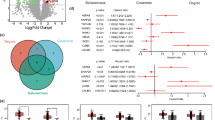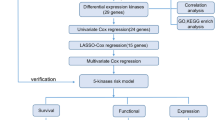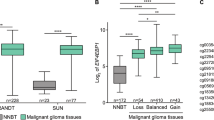Abstract
Aim:
To determine whether elongation factor-2 kinase (eEF-2 kinase) contributes to the malignant phenotype of glioblastoma multiforme by promoting the migration and invasion of glioma cells. The mechanism involved was also explored.
Methods:
Human glioma cell lines T98G and LN-229 were used. The expression of eEF-2 kinase was silenced using siRNA, and the invasive potential of tumor cells was assessed using a wound-healing assay and a Matrigel invasion assay. Apoptosis was determined using propidium iodide (PI) staining and Western blot analysis of cleaved caspase-3.
Results:
Silencing the expression of eEF-2 kinase by siRNA significantly suppressed both the migration and invasion of human glioma cells. Silencing eEF-2 kinase expression also sensitized glioma cells to anoikis, thereby decreasing tumor cell viability in the absence of attachment. Treatment of tumor cells with the caspase inhibitor z-VAD-fmk down-regulated Bim accumulation and abolished glioma cell sensitivity to anoikis.
Conclusion:
The results suggest that the expression of eEF-2 kinase contributes to migration and invasion of human glioma cells by protecting them from anoikis. eEF-2 kinase expression may serve as a prognostic marker and a novel target for cancer therapy.
Similar content being viewed by others
Log in or create a free account to read this content
Gain free access to this article, as well as selected content from this journal and more on nature.com
or
References
Serfass L, Van Herpen C, Saghatchian M . Molecular targets and cancer therapeutics. Eur J Cancer 2007; 43: 1494–5.
Wu H, Yang JM, Jin S, Zhang H, Hait WN . Elongation factor-2 kinase regulates autophagy in human glioblastoma cells. Cancer Res 2006; 66: 3015–23.
Ryazanov AG, Rudkin BB, Spirin AS . Regulation of protein synthesis at the elongation stage. New insights into the control of gene expression in eukaryotes. FEBS Lett 1991; 285: 170–5.
Hait WN, Wu H, Jin S, Yang JM . Elongation factor-2 kinase: its role in protein synthesis and autophagy. Autophagy 2006; 2: 294–6.
Celis JE, Madsen P, Ryazanov AG . Increased phosphorylation of elongation factor 2 during mitosis in transformed human amnion cells correlates with a decreased rate of protein synthesis. Proc Natl Acad Sci USA 1990; 87: 4231–5.
Donze O, Jagus R, Koromilas AE, Hershey JW, Sonenberg N . Abrogation of translation initiation factor eIF-2 phosphorylation causes malignant transformation of NIH 3T3 cells. Embo J 1995; 14: 3828–34.
Herschman HR . Primary response genes induced by growth factors and tumor promoters. Annu Rev Biochem 1991; 60: 281–319.
Xu CS, Chang CF . Expression profiles of the genes associated with metabolism and transport of amino acids and their derivatives in rat liver regeneration. Amino Acids 2008; 34: 91–102.
Nunes PH, Calaza Kda C, Albuquerque LM, Fragel-Madeira L, Sholl-Franco A, Ventura AL . Signal transduction pathways associated with ATP-induced proliferation of cell progenitors in the intact embryonic retina. Int J Dev Neurosci 2007; 25: 499–508.
Edwards DR, Mahadevan LC . Protein synthesis inhibitors differentially superinduce c-fos and c-jun by three distinct mechanisms: lack of evidence for labile repressors. Embo J 1992; 11: 2415–24.
Clark DE, Errington TM, Smith JA, Frierson HF Jr, Weber MJ, Lannigan DA . The serine/threonine protein kinase, p90 ribosomal S6 kinase, is an important regulator of prostate cancer cell proliferation. Cancer Res 2005; 65: 3108–16.
Zinck R, Cahill MA, Kracht M, Sachsenmaier C, Hipskind RA, Nordheim A . Protein synthesis inhibitors reveal differential regulation of mitogen-activated protein kinase and stress-activated protein kinase pathways that converge on Elk-1. Mol Cell Biol 1995; 15: 4930–8.
Cano E, Hazzalin CA, Mahadevan LC . Anisomycin-activated protein kinases p45 and p55 but not mitogen-activated protein kinases ERK-1 and -2 are implicated in the induction of c-fos and c-jun. Mol Cell Biol 1994; 14: 7352–62.
White-Gilbertson S, Kurtz DT, Voelkel-Johnson C . The role of protein synthesis in cell cycling and cancer. Mol Oncol 2009; 3: 402–8.
Kaczmarek L, Surmacz E, Baserga R . Cycloheximide or puromycin can substitute for PDGF in inducing cellular DNA synthesis in quiescent 3T3 cells. Cell Biol Int Rep 1986; 10: 455–63.
Connolly E, Braunstein S, Formenti S, Schneider RJ . Hypoxia inhibits protein synthesis through a 4E-BP1 and elongation factor 2 kinase pathway controlled by mTOR and uncoupled in breast cancer cells. Mol Cell Biol 2006; 26: 3955–65.
Arora S, Yang JM, Hait WN . Identification of the ubiquitin-proteasome pathway in the regulation of the stability of eukaryotic elongation factor-2 kinase. Cancer Res 2005; 65: 3806–10.
Bagaglio DM, Cheng EH, Gorelick FS, Mitsui K, Nairn AC, Hait WN . Phosphorylation of elongation factor 2 in normal and malignant rat glial cells. Cancer Res 1993; 53: 2260–4.
Parmer TG, Ward MD, Yurkow EJ, Vyas VH, Kearney TJ, Hait WN . Activity and regulation by growth factors of calmodulin-dependent protein kinase III (elongation factor 2-kinase) in human breast cancer. Br J Cancer 1999; 79: 59–64.
Salhia B, Tran NL, Symons M, Winkles JA, Rutka JT, Berens ME . Molecular pathways triggering glioma cell invasion. Expert Rev Mol Diagn 2006; 6: 613–26.
Giese A, Bjerkvig R, Berens ME, Westphal M . Cost of migration: invasion of malignant gliomas and implications for treatment. J Clin Oncol 2003; 21: 1624–36.
Reginato MJ, Mills KR, Paulus JK, Lynch DK, Sgroi DC, Debnath J, et al. Integrins and EGFR coordinately regulate the pro-apoptotic protein Bim to prevent anoikis. Nat Cell Biol 2003; 5: 733–40.
Wu H, Yang JM, Jin S, Zhang H, Hait WN . Elongation factor-2 kinase regulates autophagy in human glioblastoma cells. Cancer Res 2006; 66: 3015–23.
Reddy KB, Nabha SM, Atanaskova N . Role of MAP kinase in tumor progression and invasion. Cancer Metastasis Rev 2003; 22: 395–403.
Yoeli-Lerner M, Toker A . Akt/PKB signaling in cancer: a function in cell motility and invasion. Cell Cycle 2006; 5: 603–5.
Chen Y, Matsushita M, Nairn AC, Damuni Z, Cai D, Frerichs KU, et al. Mechanisms for increased levels of phosphorylation of elongation factor-2 during hibernation in ground squirrels. Biochemistry 2001; 40: 11565–70.
Collins NL, Reginato MJ, Paulus JK, Sgroi DC, Labaer J, Brugge JS . G1/S cell cycle arrest provides anoikis resistance through Erk-mediated Bim suppression. Mol Cell Biol 2005; 25: 5282–91.
Tan TT, Degenhardt K, Nelson DA, Beaudoin B, Nieves-Neira W, Bouillet P, et al. Key roles of BIM-driven apoptosis in epithelial tumors and rational chemotherapy. Cancer Cell 2005; 7: 227–38.
Acknowledgements
This project was supported by the National Natural Sciences Foundation of China (K113416510) and Natural Science Foundation of Jiangsu Province of China (BK2010224) and US Public Health Service R01CA135038.
Author information
Authors and Affiliations
Corresponding author
Rights and permissions
About this article
Cite this article
Zhang, L., Zhang, Y., Liu, Xy. et al. Expression of elongation factor-2 kinase contributes to anoikis resistance and invasion of human glioma cells. Acta Pharmacol Sin 32, 361–367 (2011). https://doi.org/10.1038/aps.2010.213
Received:
Accepted:
Published:
Issue date:
DOI: https://doi.org/10.1038/aps.2010.213



